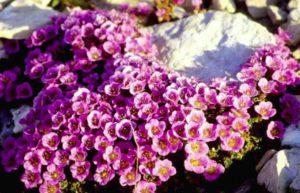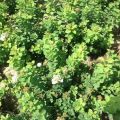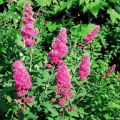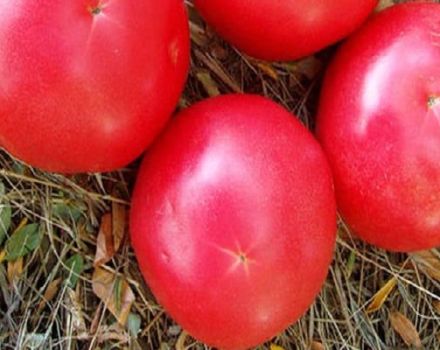Description of the Japanese spirea Frobeli, the subtleties of growing and care
The beautifully flowering shrub of the Japanese Frobeli spirea often attracts attention in city parks and squares. But gardeners especially fell in love with the flower as an original decoration of the local area. There are more than 100 species in the genus, distributed in the northern hemispheres of the planet. Asian breeders have bred the species of Japanese Frobeli spirea. Until now, southwestern China is considered the center for the conservation and development of the Spiraea japonica species.
General information about spiraeus of Japanese Frobeli
Froebelii is a short shrub, growing from 0.7 to 1.2 m in diameter, the same amount in height. The crown is spherical, erect branches. It has the peculiarity of all types of spirea to change the color of the foliage during the season: in summer they are green, when the seasons change, they are purple-red.
Japanese spirea blooms from late July to September. Abundant flowering immediately attracts the eye. Pink inflorescences up to 12 cm in diameter, formed by dense corymbose inflorescences.
Positive and negative sides of the variety
Spirea is a Japanese summer species, it blooms and fragrant accordingly in the warm season. The bright, rich color of the shrub attracts attention from afar. If planted as a separate growing bush, it will stand out as a bright spot against the background of the garden.
In spring and late autumn, only branches are visible, they do not shine with special beauty. Mature shrubs fill the space well, do not let the weeds through. They do not require complex care, but regular watering and nutrition allow the Japanese spirea flower caps to be larger.
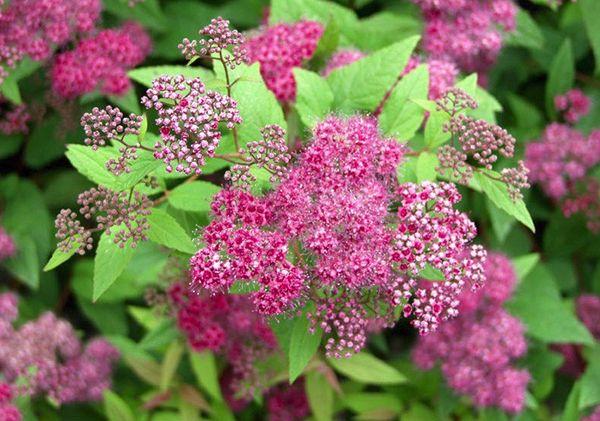
Growing features
A place must be allocated for the seedling, taking into account the adult state of the bush. The first year, you can plant ground cover plants nearby. In the future, Japanese spirea will grow, it will take a diameter of 1.2 m.Do not thicken the planting, the shrub will develop poorly. Annual growth is 10-12 cm in height.
A shrub grows in partial shade, conifers are excellent neighbors: thuja, junipers, also contrasting hosts and heucheras. In a gardening store you can buy planting material: seeds, roots, cuttings. The first method is difficult and lengthy. The second will allow the spirea to bloom in the second year of planting.
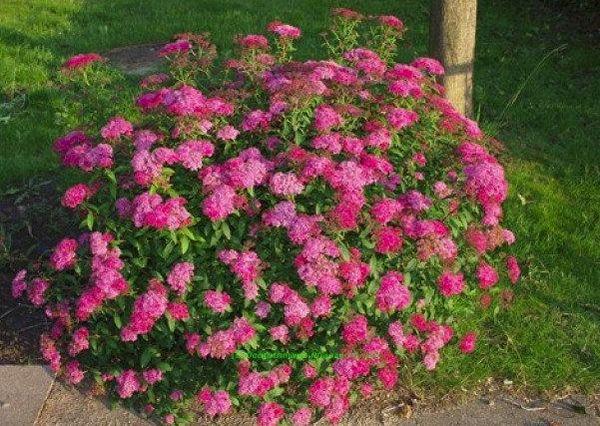
Place and time
For spirea, the place is chosen sunny or partial shade. If it is a hedge, then shrubs are planted along the planned place at a distance of 0.7-1.2 m from each other. When planting Japanese spirea in a permanent place in a flower garden, the height of adjacent plants, as well as the color of neighboring shrubs, are taken into account. Contrasting or one color at the gardener's choice.
Summer-flowering spirea Frobeli is planted in the spring until mid-May. In autumn, until September 5-10, the shrub takes root well on cool days. A place is selected in advance. The soil is prepared by carefully choosing the weeds, otherwise young seedlings will crush aggressive weeds. The soil should be slightly acidic or neutral.

Planting a plant
A cloudy but not rainy day is a great time to plant the Japanese Frobeli spirea. For long flowering in one place, you need to prepare the soil:
- If possible, make drainage, lay a layer of large expanded clay, broken brick in a ditch 50-70 cm deep.
- Mix the soil with peat, leaf mixture.
- Add fertilizers, spring or complex for flowering shrubs are suitable.
- After planting, cover with sawdust 2-3 cm, this will protect from germination of weeds.
- The hole for one bush should be 3 times the size of the root system. Prepare for 3-4 days, then drain, shed well.
The processed planting material is planted to a depth of 0.4 meters, the root collar should not be buried. The stalk is placed in a hole and covered with earth, well compacted. The layers must be washed, dried a little, and the roots must be separated. Be sure to treat it against fungal diseases and send it to a new place.

Further care of the bush
Regular watering, feeding and pruning of dead buds is all that is required for good development. During the growing season, the bush must be regularly inspected, diseases may develop or pests may attack, this can be dealt with with proper agricultural technology.
Watering rules
Spirea is unpretentious, the plant regulates the water balance on its own. During drought, it is necessary to water with warm, settled water. 10-15 liters will be enough early in the morning or after 18:00 hours.
Watering is recommended under the bush so that water does not get on the flowers. Green branches can perfectly moisturize when it rains.
Fertilization
Watering is combined with fertilization. In spring, when planting or digging, preference is given to complex fertilizing with a predominance of nitrogen. This will provide an opportunity to build up green mass and prepare for abundant flowering.
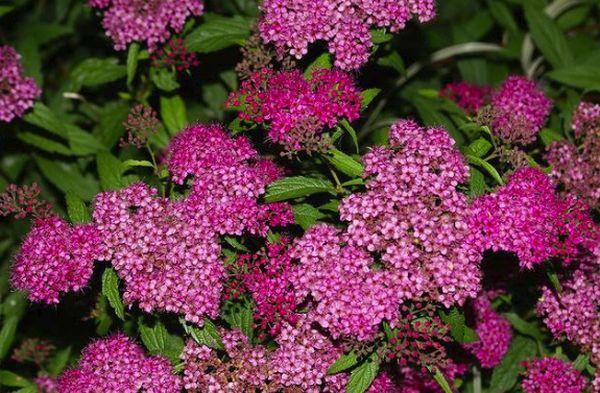
In the summer months, potash-phosphorus mixtures are added. Every 3 weeks with watering of the bush. Simple phosphorus is added for wild flowering. You need to apply dry fertilizers directly to the soil, close up with a rake and water abundantly.
Spraying with stimulating and anti-stress drugs is possible in spring and summer. Microfertilizers allow you to survive early spring frosts and summer heat. During the season, it is recommended to use 3 sprays with Epin, Zircon and other products with similar properties.
Even with a balanced diet, the flowering of the spirea cannot be extended, but the flowers will look luxurious throughout the period.
Pruning
To form beautiful bushes, pruning of Japanese Frobeli spirea is required. The plant begins to form immediately after the branches grow by 30 cm. The owner chooses the shape according to the style of the landscape, it can be spherical or pyramidal. They do not choose a square one, even if it is a hedge.
During the summer, hygienic pruning is carried out, faded buds and withered branches are removed. So new buds grow faster, and the bush will always be in blooming state.
Pests
Pests love fragrant and juicy spirea. It is necessary to fight them as soon as you see that something is wrong with the bush.

Spider mites attack on the first warm days. The plant is enveloped in cobwebs, the leaves look dull. Spraying with special solutions is suitable. Works well "Karbofos", dilute strictly according to the attached instructions, spray in cloudy weather.
Aphids attack in the heat. Sucks sap from leaves and stems of plants.The leaves fold, if you do not fight the pest, by the fall the culture will be weakened, it may not overwinter. It is especially bad when branches are affected. It is necessary to fight aphids; all biological and chemical agents can be used.
Spirea diseases
Various types of spotting can affect: phyllostictic, cercospora, ascochitous. They affect foliage with ugly spots, start at the edge of the leaf, then cover the entire leaf. Treatment: proper agricultural technology, processing of planting material, removal of the first diseased leaves.
Reproduction of culture
Three methods of reproduction of spirea allow you to choose the most convenient one in a particular region.
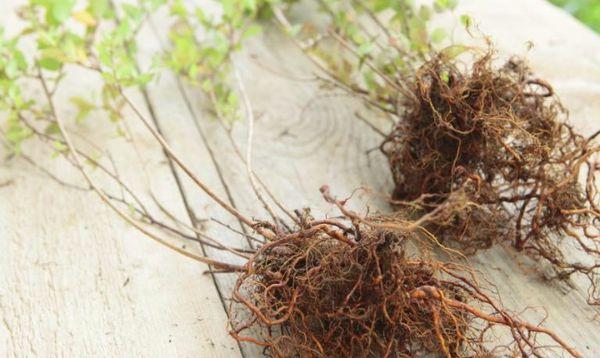
The right choice will allow you to grow a healthy large plant:
- Dividing the bush, it is better to do this in early spring. The grown, matured branches are dug up and transplanted to a new place. With this method, the spirea grows actively. Before transplanting, treat the roots with a remedy for diseases.
- It is better to start cutting branches in the fall. Prepared cuttings 12-15 cm are treated with fungicidal solutions, laid on a nutritious soil. This should be done in a cool room. The box is covered with a black film, left until the first buds appear.
- Reproduction by layering is the most effective way. The branches of an adult healthy seedling are bent to the ground, sprinkled. Over the summer, it takes root from a new plant, then planting in a permanent place.
Spirea seeds are also recommended to be germinated at home in cool conditions. Create greenhouse conditions for young sprouts from early spring, and they will develop healthy throughout the growing season. In well-established warm weather, land on the street.
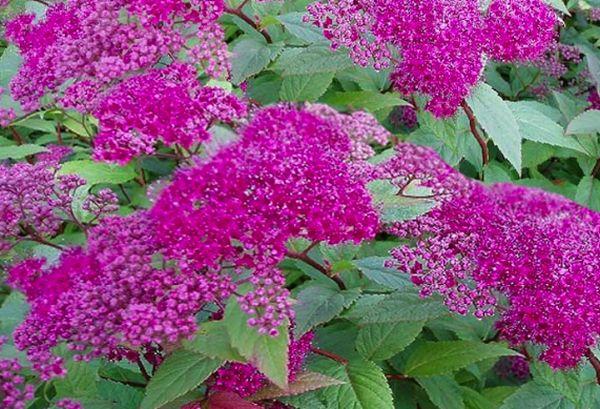
Application in landscape design
Spirea is a summer flowering species. The shrub is great for hedging in garden areas. Long bloom allows planting it along footpaths and recreation areas. Looks great along the fence, forms an endlessly flowering path.
Used to create flower beds. Pick up nearby plants according to the flowering time, and the flower garden will be beautifully blooming all summer, and the main role will be played by the Japanese spirea Frobeli.
You can create a mixborder not only from the Frobeli spirea, but also use other similar ones. A variety of colors will create a whole flower sea. If it is necessary to refine a place with trees on the site, then it is better than Japanese Frobeli spirea to find. Looks decorative under tall pines, designers often make the transition to shorter flowers with the help of flowering shrubs.

